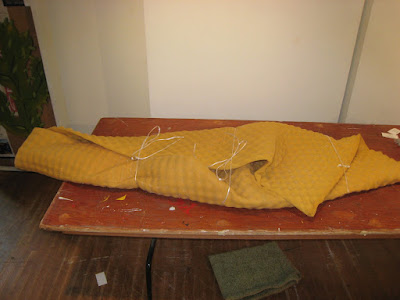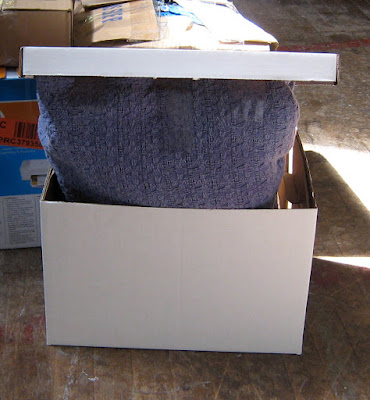

 Three examples of how NOT to pack your sculpture.
Three examples of how NOT to pack your sculpture.Good packing begins with a sound container, one that protects the art on all sides. I hate to break the news, bubble wrap is padding not a container. It goes inside the box. Don't use foam peanuts unless they are sealed inside a plastic bag. No one likes the explosion of hard to sweep up peanuts. The padding needs to cushion and support the sculpture to keep it from shifting. And it goes inside a box.
On the outside of a good packing case there is a photograph of your art along with a printed list of well thought out instructions on unpacking and repacking. Step by step. This is respectful of the gallery or museum staff's time because clear instructions make for efficient use and reuse of your materials and their time. The person who uncrates your art is often not the one who transported it or who repacks it. Even when it is the same person, “You think you'll remember how it was packed, but a month later you don't.” one volunteer said. The best travel insurance you can give your art is a well-designed shipping case.
How did our PNWS cartons look? They looked like foundlings dumped on the museum doorstep in the hope of a better life. Repacking the show was like cleaning up after a thoughtless, sloppy houseguest. Dirty stained sheets, blankets covered in cat hair. Boxes that were road kill. This shows our art at its best?
If you had work in the Coos Bay Museum of Art show, do you realize that it traveled more than 934 bumpy, twisting miles at 65 miles an hour? That's a lot of vibrations, potholes and settling. Do you really believe paper or bubble wrap or soft foam alone will protect your art on a such long trip? Do you also believe in shop elves that clean the studio at night?
Loading the trailer requires art to be packed as tightly as possible to maximize the number of boxes carried and to reduce shifting in the load. A strong box can be stacked and easily strapped in place. Our art poked out of so many boxes it looked as if had grown two sizes in transit. That makes the art much so harder to pack and impossible to protect. The lid floated on top of one sculpture like a conceptual piece. The concept: How NOT to ship your art!
You know that nice patina on your bronze? Well, it acquired another one. A rubbed patina where it bumped against something on the long trip. One bronze torso on a granite base had an impressive wooden crate. That's as far as the thinking went. Inside the box? Chaos. Broken chunks of recycled Styrofoam and no packing instructions. The heavy piece was repacked in the crate at an angle on the Styrofoam edges with the hope that the brittle foam would neither break nor rub. The other broken bits of foam were wedged around the art. Good luck.
Depending upon the kindness of strangers to decipher a jumbled mess of packing materials and care for your art is not good business. Do you think the museum staff has time to do what you don't? I can guarantee that the museum director was not impressed as he sorted through our dirty laundry trying to ensure safe return of our art.
Cardboard is one of the few things that are free for the asking. You can at least find a box that fits. Cardboard comes in many thicknesses. Double walled is stronger and safer. You can purchase it or find any appliance or gym equipment store's dumpster. Make a custom box for your art that shows you care about it and that you respect the people who show it for you and hopefully sell it. Imagine that someone buys your art. Do you want their first impression of your art arriving in their home to look like an emergency evacuation? I don't think so. If you have the skills create sculpture, you can create a container in which it will travel safely. It shows you respect your work and encourages others to as well.

No comments:
Post a Comment